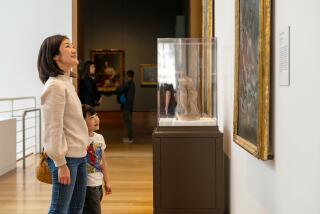See art by Austronesians, and find out who they were
“The Art of the Austronesians: The Legacy of Indo-Pacific Voyaging” is the title of a new exhibit at UCLA’s Fowler Museum, but who exactly is an Austronesian, you ask?
“Technically it’s a linguistic name of the second-largest language family in the world,” said Roy Hamilton, senior curator of Asian and Pacific collections. “We’re looking at a group of cultures related through language.”
Believed to have originated in Taiwan around 5,000 years ago, Austronesian descendants progressively occupied the Philippines, Indonesia and the Solomon Islands, eventually reaching as far away as New Zealand, Hawaii and Madagascar.
See more of Entertainment’s top stories on Facebook >>
“In prehistoric times Austronesian-speaking people covered half the globe in the Pacific and Indian oceans, and they did it all in sailing canoes long before Europeans ventured into open oceans,” Hamilton said.
Upon entering the exhibit, visitors encounter a 15-foot seafaring canoe and the similarly impressive, jovial 19th-century “Door Guardian” from New Caledonia. Other pieces, all on view until Aug. 28, include a Javanese shadow puppet, a rare aboriginal Taiwanese grain bin and textile from Sumba. The pairing of birds and reptiles such as hornbills and snakes is a recurring theme as are male and female ancestry figures.
“Lineage was of utmost importance while laying claims to new lands,” Hamilton said. “The status of a new generation depended on their being able to show who their ancestors were.”
The influence of several cultures is evident in a Balinese depiction of the Hindu deity Lakshmi made with Chinese gold coins.
See the most-read stories in Entertainment this hour >>
“The exhibit juxtaposes art from related cultures and places that people don’t necessary think of together, like Taiwan and Madagascar,” Hamilton said, referring to art made by descendants in the last two centuries.
With the exception of textiles from Sumatra, Borneo and Sumba on loan from private collectors, the majority of the 200 objects on view are drawn from the Fowler’s Henry Wellcome collection. Some haven’t been shown since 1960, and others are being exhibited for the first time.
More to Read
The biggest entertainment stories
Get our big stories about Hollywood, film, television, music, arts, culture and more right in your inbox as soon as they publish.
You may occasionally receive promotional content from the Los Angeles Times.






